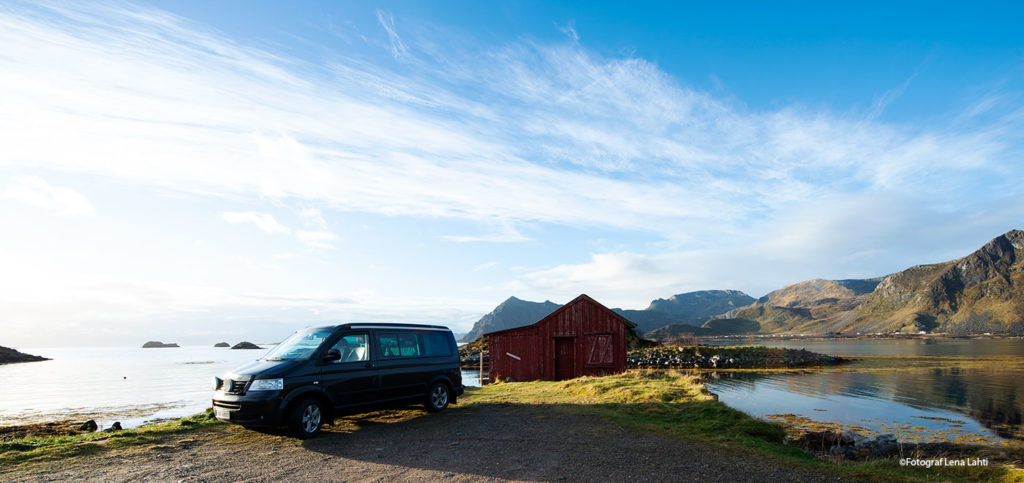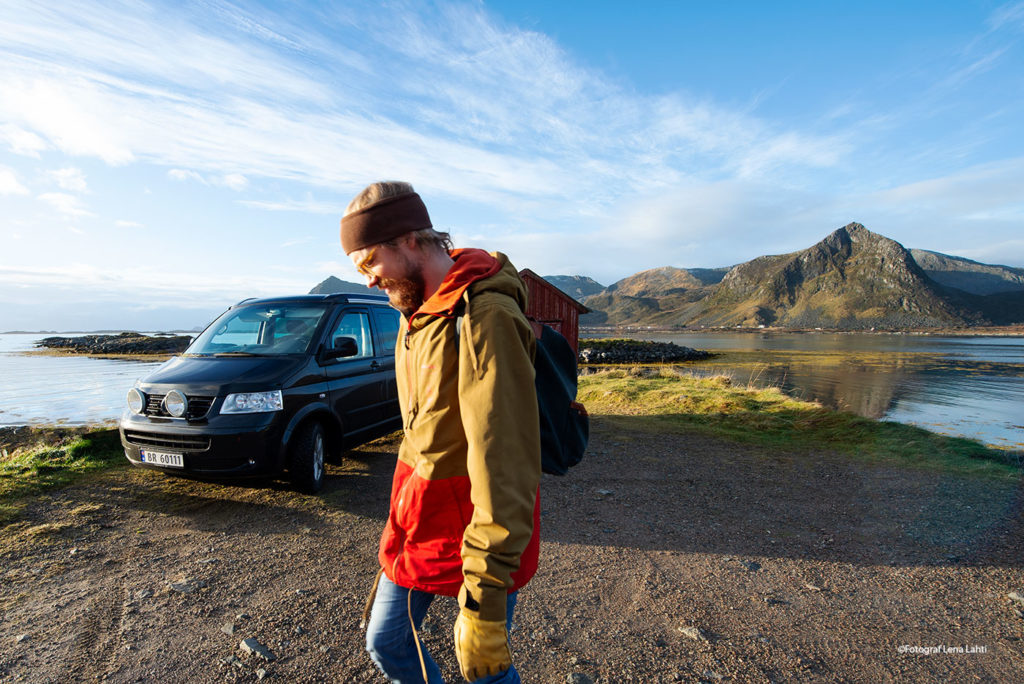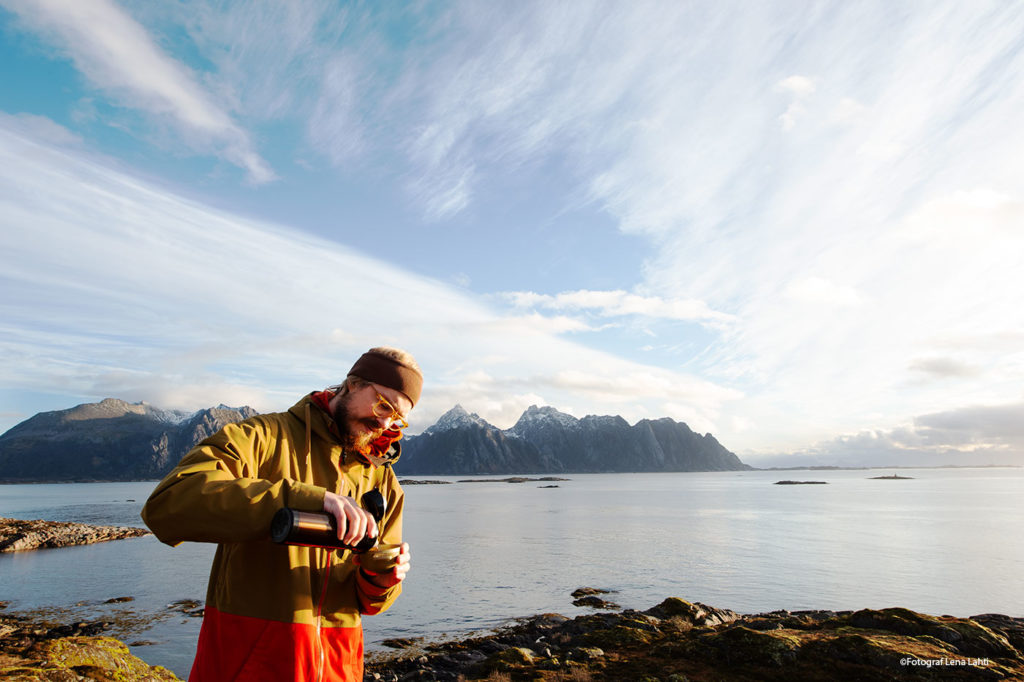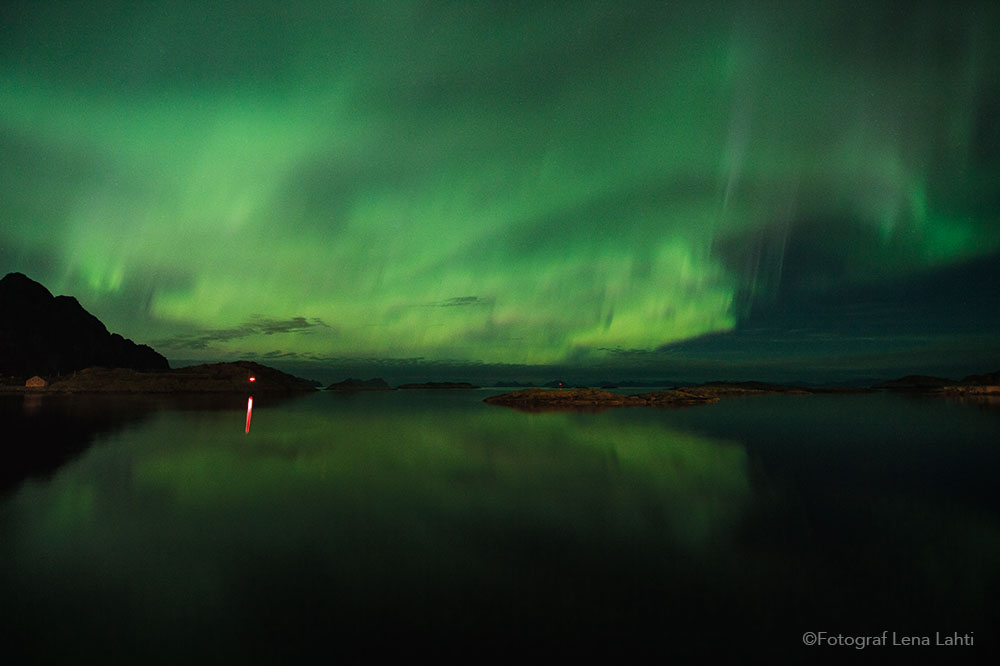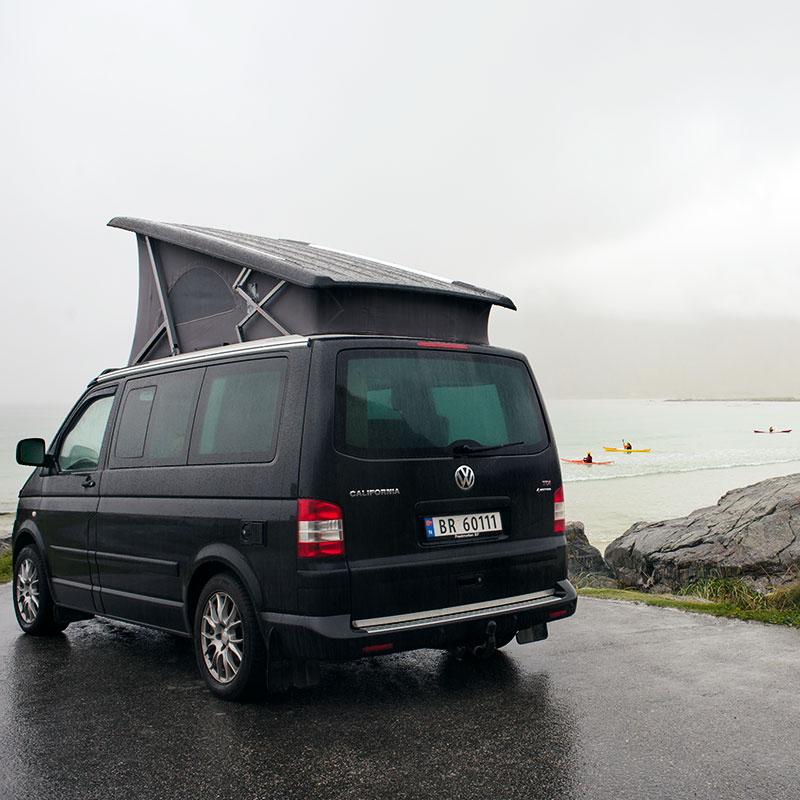Complete Campervan Guide to Lofoten Islands: Year-Round Camping Across All 5 Islands (2025)
️ Lofoten Islands Overview: Where to Camp by Island
The Lofoten Islands stretch over 100 kilometers from northeast to southwest, connected by the scenic E10 highway. Each island offers unique camping experiences:
- Austvågøya (East): Largest island with Svolvær and Henningsvær
- Gimsøya: Small connecting island with beaches and golf
- Vestvågøya (West): Agricultural center with Leknes and famous beaches
- Flakstadøya: Dramatic peaks and fishing villages
- Moskenesøya: Southern tip with iconic Reine and Å villages
️ AUSTVÅGØYA – Eastern Lofoten Campervan Sites
Austvågøya is the largest Lofoten island, home to Svolvær (the main town) and the picturesque fishing village of Henningsvær.
1. Lofoten Feriesenter – Svolvær
The only year-round campsite in Svolvær
Year-Round Operations
- Open: All year round (one of the few fully year-round sites in Lofoten)
- Winter Services: Full heating, winter-ready facilities
- Summer Season: May to September (peak services)
Campervan Facilities
- Motorhome pitches with 16A electricity available
- Service building with showers, toilets, kitchen facilities
- Dump station for gray and black water
- Laundry facilities (additional fee: 50 NOK)
- Free WiFi throughout the site
- Sauna facilities available
- Small kiosk at reception for basic supplies
Pricing
Special Features
- Idyllic location beside Lake Svolværvannet
- 20-minute walk to Svolvær supermarkets and restaurants
- Perfect base for exploring both eastern and western Lofoten
- Conference facilities available for groups
2. Lyngvær Lofoten Bobilcamping
Motorhome specialist site with stunning fjord location
Seasonal Operations
- Open: Typically May to September
- No reservations: Drop-in only policy
- Peak Season: June to August
Campervan Facilities
- 165 touring pitches – mainly grass, some hardstanding
- All pitches: 16A electricity included
- Service facilities: Modern shower/toilet buildings (heated)
- Motorhome services: Gray water disposal, fresh water
- Kitchen facilities: Two communal kitchens with cooking facilities
- Laundry: Washing machines and dryers (30 NOK each, card payment)
- Free WiFi available
- Boat rental: Canoes, rowing boats, and motor boats
- Free fishing in site’s own salmon and trout waters
Pricing
Special Features
- Spectacular location beside Henningsvær Strait
- Built in 1991/1992 – established, well-maintained site
- Fresh bread and rolls baked to order by owners
- Swimming areas and lagoons on nearby islets
- Central Lofoten location – perfect for day trips both directions
- Close to Henningsvær (“Venice of Lofoten”) – 3km
3. Kabelvåg Feriehus & Camping
Historic site with year-round facilities
Year-Round Operations
- Open: All year round
- Winter Activities: Cross-country skiing from site, northern lights viewing
- Summer Activities: Hiking trails start from campsite
Campervan Facilities
- Large pitches for motorhomes and caravans
- 220V 16A power outlets at all motorhome pitches
- Water station on site
- Drainage station for waste and gray water
- Service building: Showers, toilets, kitchen, laundry room
- Wheelchair accessible facilities
- WiFi: Free throughout site and cabins
Pricing
Special Features
- Historic Nordlandshus from 1880s available for rent
- Child and family-friendly environment
- Sheltered from wind by natural surroundings
- Walking distance to fishing lakes
- Winter skiing trails pass right by the campsite
- Close to Lofoten Museum, Aquarium, and Galleri Espolin
️ GIMSØYA – The Connecting Island
️ VESTVÅGØYA – Western Lofoten Campervan Sites
The agricultural heart of Lofoten with Leknes town and world-famous beaches like Haukland and Uttakleiv.
4. Lofoten Beach Camp – Ramberg
The largest and most popular beachfront campsite in Lofoten
Year-Round Operations
- Summer Season: May to October (full services)
- Winter Season: February to May (limited services, winter camping available)
- Winter camping: Increasingly popular for northern lights viewing
Campervan Facilities
- 100 electric pitches with 16A power (+80 NOK)
- Additional non-electric pitches available
- Gray water disposal – easy access multiple locations
- Chemical waste disposal for toilets
- Drinking water taps throughout site
- Brand new shower/toilet facilities (2024 renovation)
- 6 electric vehicle chargers (additional fee)
- Free WiFi for all guests
- Beach Sauna (additional fee)
- Beach Bar: Full service restaurant and bar
Pricing
Special Features
- No pre-bookings – first come, first serve (arrive before 18:00 in summer)
- Camp directly on the beach with stunning sea views
- Perfect for northern lights viewing (low light pollution)
- Surfing lessons and equipment rental available
- Central location for Ryten, Kvalvika, Reinebringen, Reine access
- Beach Bar serves meals all day + evening entertainment
5. Sandsletta Camping – Laukvik
Lofoten’s oldest campsite – 60+ years of operation
Seasonal Operations
- Open: May to September/October
- Family-run: Third generation operation
- Heritage: Lofoten’s first campsite (established 1963)
Campervan Facilities
- Mixed pitches: Both grass and paved spots available
- Electricity hookups available
- Shared kitchen facilities well-equipped
- Sanitary facilities: Clean, regularly maintained
- On-site restaurant serving local cuisine and fresh bread
- Wood-fired sauna and traditional Nordic baths (additional fee)
- Free boat rental: Rowing boats and pedal boats for guests
- Free WiFi throughout site
Pricing
Special Features
- Historic significance – over 60 years of hospitality
- Beautiful fjord location surrounded by high mountains
- Fresh bread and pastries available each morning
- Excellent customer service and local knowledge
- Alternative scenic route to Vesterålen via Straumnes
- 22 cabins available (from basic to luxury)
️ FLAKSTADØYA – Southern Central Lofoten
Dramatic mountain peaks and charming fishing villages.
6. Reineholmen Motorhome Camp – Ballstad
Unique: Camp on a man-made island – exclusively for motorhomes
Seasonal Operations
- Open: Typically May to September
- Reservations: Both booking and drop-in available
- Unique concept: Motorhome-only island camping
Campervan Facilities
- Exclusively for motorhomes – no tents allowed
- Electricity and water included in price
- Dump station: Both portable and fixed tank systems
- Service house: WC and shower facilities
- Swimming steps: Direct sea access
- Kayak launching: Perfect sea access for water sports
- 20-berth marina: Floating jetty with facilities
Pricing
Special Features
- Truly unique experience – park on a purpose-built island
- Walking distance to Ballstad restaurants and services
- Historic location – former fishing operations site
- Direct fishing access from your motorhome
- “Closest to the sea” camping experience possible
- Protected harbor location
️ MOSKENESØYA – Southern Lofoten
The dramatic southern tip including iconic villages of Reine and Å.
7. Moskenes Camping
Gateway campsite near the ferry terminal
Seasonal Operations
- Open: Mid-March to end of October
- Ferry access: Perfect for mainland connections
- Reservations: Available 1-2 days before arrival
Campervan Facilities
- Space for ~100 campers and many tents
- Two service buildings with showers and toilets
- Kitchen facilities available
- Laundry: 50 NOK additional fee
- Chemical waste disposal and fresh water
- Spectacular views of the complete “Lofoten Wall” mountain range
Pricing
Special Features
- Only campsite where you can see the entire Lofoten Wall
- Gateway location – perfect for ferry arrivals/departures
- Historic significance – views of abandoned settlement ruins in Reinefjorden
- Close to final destinations: Reine (15km) and Å (5km)
- Strategic position for exploring southern Lofoten attractions
️ VESTERÅLEN (North of Lofoten)
8. Andenes Camping
Whale watching capital with white sandy beaches
Seasonal Operations
- Open: Typically May to September
- Whale season: June to September (prime whale watching)
Campervan Facilities
- Oceanfront pitches available
- White sandy beach access
- Basic facilities: Toilets, showers
- Grocery store: 200 meters from site
- Waste disposal facilities
Pricing
Special Features
- Whale safari bookings available on-site
- Spectacular beach location – Caribbean-like white sand
- Midnight sun viewing in summer
- Puffin watching opportunities
- Gateway to Arctic exploration
️ Seasonal Camping Guide: When to Visit Lofoten
Summer Season (June-August)
Advantages:
- Midnight sun – 24-hour daylight
- All campsites open with full services
- Warmest weather (15-20°C typical)
- All hiking trails accessible
- Peak activities: Fishing, kayaking, surfing
Considerations:
- Busiest season – arrive early at non-reservation sites
- Higher prices during peak weeks
- Road congestion especially around famous viewpoints
Shoulder Seasons (April-May, September-October)
Advantages:
- Northern lights begin returning (September onward)
- Fewer crowds and lower prices
- Dramatic weather and photography opportunities
- Autumn colors (September)
Considerations:
- Some campsites may have limited services
- Weather variability – be prepared for storms
- Shorter daylight hours (but still substantial)
Winter Season (November-March)
Advantages:
- Northern lights season at its peak
- Winter activities: Cross-country skiing, winter surfing
- Unique atmosphere – snow-covered dramatic landscapes
- Fewer visitors – peaceful and authentic experience
Considerations:
- Limited campsite availability – mainly Lofoten Feriesenter and Kabelvåg
- Extreme weather conditions possible
- Rental requirements: Previous winter driving experience needed
- Shorter days but spectacular light quality
Campervan Rental Companies in Lofoten Region
Lofoten VW Campers
Locations: Henningsvær(The heart of Lofoten)
Website: www.lofotenvwcamper.com
Specialty: Arctic winter-ready fleet with unlimited mileage, Manual transmissions, 4WD , and powerful heating systems.
Lofoten Vanlige
Locations: Svolvær (Lofoten)
Website: www.arcticcampers.no
Specialty: Summer fleet with unlimited mileage, both manual and automatic transmissions,
Arctic Campers
Locations: Oslo and Tromsø (150km from Lofoten)
Website: www.arcticcampers.no
Specialty: Arctic winter-ready fleet with unlimited mileage, automatic transmissions, 4WD options, and powerful heating systems.
Wecamp – Evenes Airport
Address: Flyplassveien 36, 8536 Evenes
Website: www.wecamp.no
Advantage: Right at Evenes Airport – walk from terminal. All-season campervans with wooden interiors, off-grid capability, and powerful parking heaters.
Important Lofoten Camping Regulations (Updated 2025)
Budget Planning for Lofoten Campervan Trip
Daily Costs (2025 Estimates)
Top 10 Must-Visit Spots Accessible by Campervan
- Reine – The postcard-perfect fishing village
- Haukland Beach – White sand “Caribbean” beach
- Henningsvær – “Venice of Lofoten” fishing village
- Uttakleiv Beach – Sunset photography paradise
- Nusfjord – Preserved historic fishing village
- Å – The end of the world (literally – end of E10)
- Skagsanden Beach – Surfing and Lofoten Beach Camp location
- Kabelvåg – Historic “capital” of Lofoten
- Unstad – Arctic surfing capital
- Kvalvika Beach – Pristine wilderness beach (hike required)
Emergency Contacts & Important Numbers
Conclusion: Your Lofoten Campervan Adventure Awaits
The Lofoten Islands offer an unparalleled campervan experience, combining dramatic Arctic scenery with well-developed infrastructure across all five main islands. From the year-round facilities in Svolvær to the unique island camping at Reineholmen, each site offers distinct advantages for exploring this magnificent archipelago.
This guide was last updated in August 2025. Contact information and prices verified from official sources. For the most current information, always contact campsites directly before your visit.

